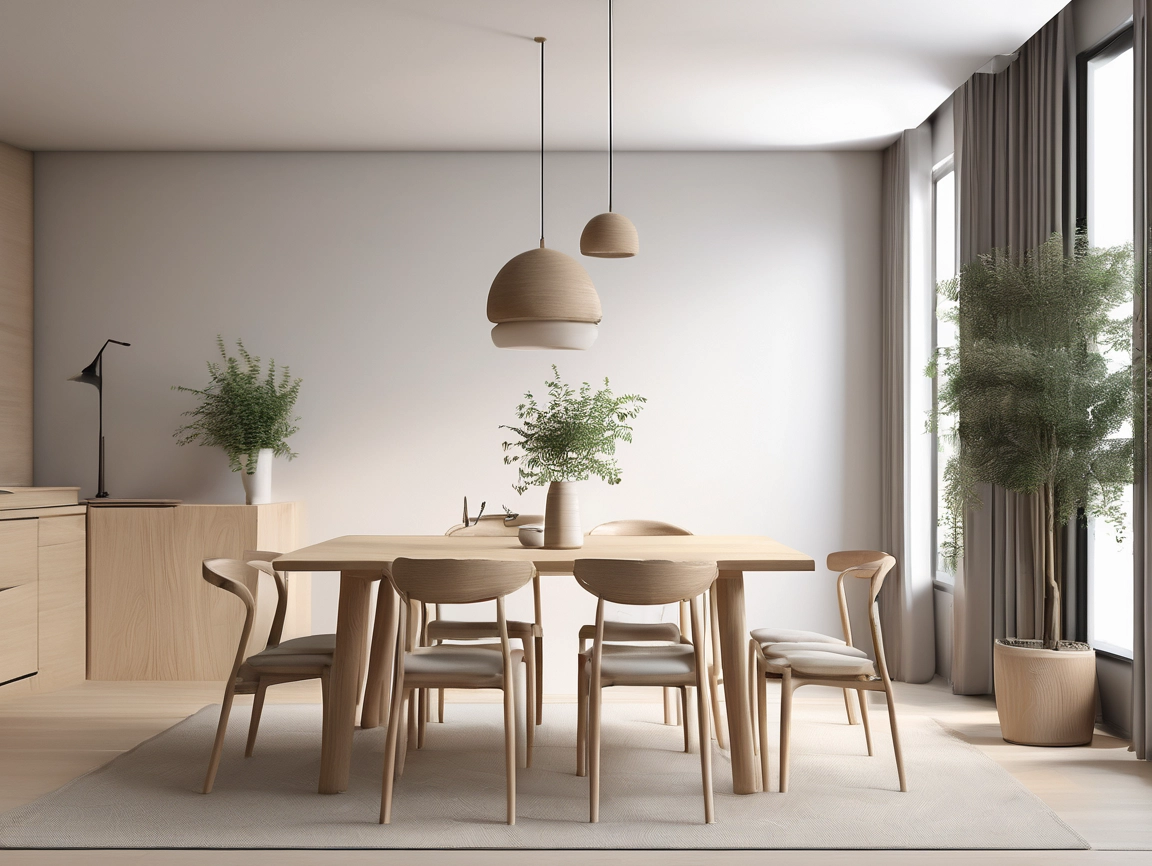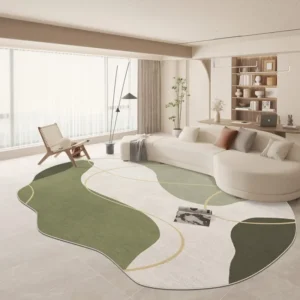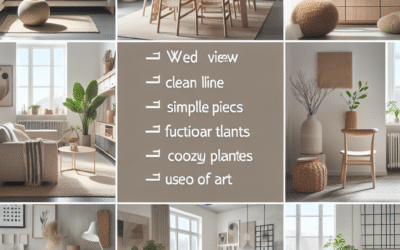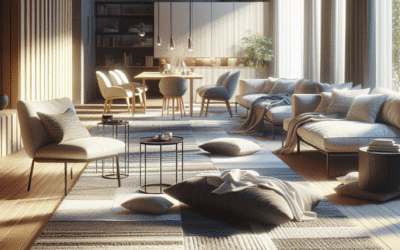
Imagine a dining space that whispers serenity rather than shouts for attention, where every element serves a purpose, and natural beauty takes center stage. This isn’t just a dream; it’s the essence of Japandi minimalist dining with natural woods. In a world often overflowing with clutter and ostentation, carving out a sanctuary for meals, conversation, and quiet reflection feels more essential than ever. We’ve all experienced the overwhelm of a chaotic home, the mental drain of visual noise. What if your dining area could be a haven, a place of calm and connection?
This comprehensive guide will show you how to transform your dining experience into just such a haven, merging the tranquil principles of Japanese aesthetics with the warm functionality of Scandinavian design. You’ll discover how the strategic use of natural woods isn’t just a trend, but a foundational pillar in creating a space that looks effortlessly elegant, feels incredibly inviting, and performs its duties without fuss. We’re talking less about fleeting trends and more about timeless design that enhances your daily life, making every meal a moment of mindful enjoyment. Get ready to explore the heart of Japandi: where natural textures, clean lines, and an understated palette converge to create dining spaces that soothe the soul and nourish the body.
By the end of this journey, you’ll not only understand the philosophy behind Japandi but also gain actionable insights, practical tips, and specific recommendations to curate your own perfectly balanced minimalist dining room, centered around the enduring beauty of natural woods. We’ll delve into everything from choosing the right timber and understanding its grain, to selecting complementary furniture, lighting, and textiles that elevate your space without overwhelming it. Ready to embrace a dining aesthetic that champions peace, purpose, and unparalleled style?
What is Japandi Dining? Blending East & West Serenity
Before we dive into the specifics of natural woods, let’s solidify our understanding of Japandi as a design philosophy, particularly when applied to the dining experience. Japandi isn’t just a catchy portmanteau; it’s a profound stylistic fusion that brings together the best of two influential design cultures: Japanese minimalism and Scandinavian functionalism. While seemingly disparate, these two aesthetics share a deep respect for simplicity, natural materials, craftsmanship, and the beauty of imperfection, making their union remarkably harmonious.
The Core Philosophies: Wabi-Sabi Meets Hygge
At its heart, Japandi dining embodies a reverence for these distinct, yet complementary, philosophies:
- Wabi-Sabi (Japanese): This ancient Japanese worldview embraces the beauty of imperfection, transience, and natural cycles. In design, it translates to appreciating the raw, unrefined qualities of materials, valuing handcrafted items over mass-produced uniformity, and finding elegance in asymmetry and age. For your dining space, Wabi-Sabi means celebrating the unique grain of a wooden table, the subtle variations in handcrafted ceramics, or the gentle patina that develops over time. It’s about finding charm in the authentic, the slightly rough-hewn, and the genuinely unique.
- Hygge (Scandinavian): Originating from Denmark and Norway, Hygge (pronounced “hoo-gah”) is more than a design style; it’s a feeling of coziness, comfort, and contentment fostered by simple, relaxing moments. Think warm candlelight, soft textures, good company, and delicious food. In a Japandi dining context, Hygge contributes the sense of inviting warmth, ergonomic design, and a focus on creating a space where people genuinely feel good and want to linger. It’s about functionality that prioritizes human comfort and happiness.
The magic of Japandi lies in how it balances these two. Wabi-Sabi offers the aesthetic depth and appreciation for natural rawness, while Hygge provides the inviting warmth and practical comfort. The result for dining is a space that is both elegantly sparse and warmly inviting, functional yet deeply soulful. It’s clean without being sterile, and cozy without being cluttered.
Key Characteristics of Japandi Dining Aesthetics
When you walk into a Japandi dining room, certain elements immediately signal its aesthetic:
- Minimalism: Not cold, stark minimalism, but a thoughtful, purposeful reduction of clutter. Every item has a reason for being there, contributing to the overall calm. Storage is often integrated and discreet.
- Natural Materials: This is where natural woods shine, but also woven textures, ceramics, linen, bamboo, and natural fibers. These materials bring an organic, earthy feel and tactile richness to the space.
- Neutral Palette with Subtle Contrast: Dominant colors are typically subdued – whites, off-whites, warm grays, and soft beiges. However, Japandi often introduces contrasting darker shades (e.g., charcoal, deep indigo, or black) from Japanese aesthetics, providing visual anchor points and sophisticated depth, preventing the space from feeling bland.
- Clean Lines & Simple Forms: Furniture tends to have straightforward, uncluttered silhouettes. Think elegant simplicity over elaborate ornamentation. Functionality guides the form.
- Emphasis on Craftsmanship: Hand-finished pieces, bespoke furniture, and items with a story often find a place here, aligning with the Wabi-Sabi appreciation for authenticity.
- Connection to Nature: Beyond just natural materials, Japandi spaces often incorporate subtle nods to the natural world – a thoughtfully placed plant, a view to the outdoors, or artwork inspired by landscapes.
In essence, Japandi dining creates an environment where you can truly focus on the act of eating, sharing, and connecting, free from unnecessary distractions. It’s about quality over quantity, purpose over pretense, and timeless elegance over fleeting trends. And at the very core of this aesthetic, providing both structure and warmth, are natural woods.
Image Suggestion: A minimalist Japandi dining room with a light natural wood table, mismatched chairs, and a single, elegant plant.
Alt Text: Japandi dining room showcasing a light natural wood table and minimalist chairs, embodying serene East-meets-West design.
Why Natural Woods Are the Pillars of Japandi Dining
When you envision a Japandi dining space, what immediately comes to mind? For many, it’s the warm, inviting presence of wood. This isn’t accidental. Natural woods are not merely a material choice in Japandi design; they are fundamental to its very definition and success. Their inherent qualities perfectly align with the core tenets of both Japanese minimalism and Scandinavian functionality, making them indispensable.
Embracing Authenticity and Imperfection
One of the most compelling reasons for the centrality of natural woods is their strong connection to Wabi-Sabi. Each piece of wood tells a story. Its grain patterns, knots, unique color variations, and even minor imperfections are not flaws but markers of authenticity and character. Unlike engineered materials, wood has a life of its own:
- Unique Grain Patterns: No two pieces of wood are exactly alike. This natural artistry adds unparalleled visual interest and a sense of uniqueness that manufactured materials simply cannot replicate. It’s a quiet celebration of nature’s design.
- Tactile Warmth: Wood possesses a natural warmth, both visually and to the touch, that instantly makes a space feel more inviting and less sterile. This tactile quality is crucial for creating comfortable, “Hygge-like” environments where you want to spend time.
- Aging Gracefully: As wood ages, it develops a beautiful patina, deepening in color and acquiring a rich history. This resonates deeply with the Wabi-Sabi appreciation for transience and the beauty of wear, making a piece even more cherished over time.
Using natural wood in your dining area isn’t just about selecting furniture; it’s about inviting a piece of the natural world indoors, connecting your meals to the earth’s rhythm and honest materials.
Functionality and Sustainability
From the Scandinavian perspective, wood is a highly functional and sustainable material. Scandinvian design prioritizes practicality, durability, and responsible sourcing. Natural wood excels in all these areas:
- Durability: High-quality solid wood furniture is built to last. A well-crafted wooden dining table or set of chairs can withstand daily use for decades, becoming heirloom pieces. This longevity aligns with a minimalist ethos – investing in fewer, higher-quality items.
- Versatility: Wood can be shaped, stained, or left natural to suit a multitude of design preferences, from light and airy to dark and grounded. It effortlessly integrates with various textiles and decorative elements.
- Sustainability: When sourced responsibly from managed forests (look for FSC certification), wood is a renewable resource. Its production often has a lower environmental impact compared to many synthetic materials, aligning with a conscious, mindful approach to living that both Japanese and Scandinavian cultures value. It allows for creating a home that respects the planet.
For Japandi dining, the choice of natural wood goes beyond aesthetics; it’s a conscious decision that reflects a deeper appreciation for mindful living, enduring quality, and ecological responsibility. It creates a grounding element, a stable anchor in a world of fleeting trends, offering solace and strength to your dining experience.
Image Suggestion: Close-up of a raw, unfinished natural wood table surface showing prominent grain and subtle imperfections.
Alt Text: Close-up of a live-edge natural wood dining table, highlighting unique wood grain and authentic textures, perfect for Japandi design.
The Heart of the Home: Choosing Your Japandi Dining Table
The dining table is unequivocally the centerpiece of your dining area. In Japandi design, it’s not just a surface for food; it’s the anchor for connection, conversation, and quiet moments. Selecting the right natural wood dining table requires careful consideration of wood type, finish, form, and scale.
Popular Natural Woods for Japandi Tables
The choice of wood profoundly impacts the aesthetic and durability of your dining table. Here are some of the most popular and suitable natural woods for Japandi:
Light Hardwoods (Scandinavian Influence):
- Oak: A perennial favorite, oak is known for its strength, durability, and prominent, beautiful grain. White oak is particularly popular for its light, natural tone, which aligns perfectly with Scandinavian aesthetics. It’s robust and ages gracefully.
- Ash: Similar to oak in terms of durability and grain, ash is often slightly lighter in color with a more pronounced, often straight grain. It offers a clean, airy feel, ideal for rooms that seek to maximize light.
- Maple: With a finer, less pronounced grain than oak or ash, maple offers a smoother, more uniform appearance. It’s incredibly durable and takes finishes well, often appearing very light and clean.
Medium to Dark Hardwoods (Japanese Influence & Contrast):
- Walnut: A stunning wood known for its rich, dark brown hues and often intricate grain patterns. Walnut brings a sophisticated elegance and a grounding presence. It’s perfect for adding that touch of Japanese depth and contrast to a lighter overall scheme.
- Teak: Renowned for its exceptional durability and natural oils, teak is often used in outdoor furniture but can be stunning indoors. Its warm, golden-brown tones and fine grain age beautifully, developing a silvery patina if left untreated.
- Cherry: Offers a warm, reddish-brown hue that deepens beautifully over time with exposure to light. Its fine, straight grain provides a refined look, adding warmth and richness without being overly heavy.
Exotic & Sustainable Options:
- Bamboo: While technically a grass, bamboo is processed into a hard, durable material that’s incredibly sustainable and beautiful. It offers a unique, fine grain and a light, often pale-yellow tone, aligning with the lightness and natural feel of Japandi.
- Reclaimed Woods: Sourcing reclaimed timber (e.g., old barn wood, factory floorboards) offers unparalleled character and a story. The imperfections, nail holes, and unique patina perfectly embody Wabi-Sabi. These woods are also inherently sustainable, giving new life to old materials.
Comparison: Popular Japandi Dining Woods
| Wood Type | Key Characteristics | Japandi Aesthetic Alignment |
|---|---|---|
| White Oak | Light color, prominent grain, very durable. | Scandinavian warmth, durability. |
| Ash | Lighter than oak, strong, distinctive straight grain. | Airy, clean lines, robust functionality. |
| Walnut | Rich dark brown, elegant grain, sophisticated. | Japanese depth, strong contrast, grounding. |
| Maple | Very light, fine grain, exceptionally hard. | Subtle elegance, smooth finish, bright. |
| Reclaimed Wood | Unique patinas, imperfections, rich history. | Wabi-Sabi, sustainability, character. |
Form and Finish: Less Is More
In Japandi, the table’s form is as crucial as its material. The goal is elegant simplicity. Think:
- Clean Lines: Straightforward rectangular, round, or oval tops with minimal ornamentation. The beauty comes from the material itself, not fussy details.
- Subtle Leg Designs: Tapered legs, slim profiles, or simple block legs are preferred. Avoid ornate carvings or heavy pedestals. Focus on structural integrity with understated appeal.
- Natural Finishes: Opt for matte, satin, or oil finishes that protect the wood while allowing its natural texture and grain to show through. Overly glossy or heavily stained finishes tend to detract from the Japandi aesthetic’s authenticity. A simple oil finish can enhance the wood’s natural beauty.
- Live Edge Tables: For a true Wabi-Sabi touch, consider a live edge table where the natural edge of the tree slab is preserved. This celebrates the organic, untamed beauty of the wood, bringing a powerful connection to nature.
Sizing Your Table: Proportionality Matters
Getting the scale right is vital for maintaining the minimalist, spacious feel. A table that’s too large crowds the room, while one that’s too small feels lost. Measure your space carefully and consider:
- Room for Movement: Always ensure at least 36-42 inches (90-105 cm) of clear space around all sides of the table for comfortable chair pull-out and movement.
- Number of Diners: A good rule of thumb is 24-30 inches (60-75 cm) of table length per person. Round tables are excellent for promoting conversation and can feel less imposing in smaller spaces.
Your Japandi dining table isn’t just furniture; it’s a stage for daily rituals, a silent testament to the beauty of natural materials and thoughtful design. Choose wisely, and it will serve as a warm, inviting anchor for years to come.
Image Suggestion: A sleek, light oak rectangular dining table with minimalist lines in a bright Japandi setting.
Alt Text: Modern Japandi dining table crafted from light oak, featuring clean lines and a simple rectangular top, set in a bright, airy room.
Seating Harmony: Japandi Chairs & Benches
Once you’ve chosen your magnificent natural wood dining table, the next crucial step is selecting seating that complements its aesthetic while providing ergonomic comfort. In Japandi dining, chairs and benches are not merely functional items; they are design elements that continue the narrative of simplicity, natural materials, and craftsmanship.
Embracing Simplicity and Ergonomics
Japandi seating prioritizes:
- Clean, Uncluttered Forms: Look for chairs with simple silhouettes, often made from wood, sometimes with woven accents or subtle upholstery. Elaborate carvings or heavy padding are typically avoided.
- Comfort without Bulk: While the look is minimalist, comfort is paramount. Scandinavian design emphasizes ergonomics, so chairs should be supportive and pleasant to sit in for extended periods, encouraging lingering at the table.
- Natural Materials: Solid wood (matching or complementary to your table), woven paper cord, rattan, linen, and cotton are common materials. These add texture and warmth without visual weight.
Popular Japandi Seating Styles
Several types of chairs and benches perfectly align with the Japandi aesthetic:
Classic Wooden Dining Chairs:
- Wishbone Chairs (or similar spindle back designs): Iconic for their graceful curves and sculptural lines, often in oak, ash, or beech. They offer visual lightness and an artistic touch, deeply rooted in mid-century Scandinavian design.
- Shaker-style Chairs: Simple, utilitarian designs with straight lines and ladder backs. They embody honest craftsmanship and unpretentious beauty, fitting perfectly with both Wabi-Sabi and Hygge.
- Slatted Back Chairs: Featuring clean vertical or horizontal slats, these chairs provide structure and support without feeling heavy. They often come in natural wood finishes, showcasing the timber’s inherent beauty.
Upholstered Chairs (Subtle & Textured):
- If choosing upholstered chairs, opt for natural fabrics like linen, wool, or cotton. Keep colors muted and neutral (off-white, light grey, natural beige) to maintain the serene palette. The upholstery should add a soft texture, not a splash of vibrant color.
Dining Benches:
- Solid Wood Benches: A popular choice for Japandi dining, benches offer a distinct blend of casualness and functionality. They can save space, are great for larger gatherings, and their continuous form reinforces the clean aesthetic. A long, simple wooden bench along one side of the table can look incredibly chic.
- Backless or Low-Back Benches: Maintaining an unobstructed visual line is key. Benches that are discreet and tuck neatly under the table when not in use enhance the minimalist feel.
Mixing and Matching: A Japandi Signature
One of the delightful aspects of Japandi design is its embrace of subtle asymmetry and the beauty of combining elements. Don’t feel compelled to buy a matching table and chair set. In fact, mixing and matching can add depth and character:
- Different Woods, Same Tone: Pair a light oak table with ash chairs, or a darker walnut table with lighter cherry benches. Ensure the wood tones, while different, harmonize rather than clash.
- Varying Chair Styles: Try two different styles of wooden chairs at opposing ends of the table, or use a bench on one side with individual chairs on the others. This creates visual interest and a curated, collected feel, embodying a more Wabi-Sabi, less uniform approach.
- Textural Contrast: Combine solid wood chairs with one or two chairs featuring woven elements (like paper cord seats or rattan backs) to introduce subtle textural variety.
When mixing, ensure there’s an overarching theme – perhaps a consistent height, a shared material (like wood), or a similar level of visual weight – to maintain coherence. The goal isn’t chaos, but a carefully composed balance that feels authentic and lived-in. Each piece should complement, not compete, with the others, creating a harmonious dining ensemble where every chair is an invitation to sit and savor the moment.
Image Suggestion: A Japandi dining setup with a natural wood table, one side with 2-3 minimalist wooden chairs, the other with a complementary wooden bench.
Alt Text: Japandi dining room featuring a natural wood table paired with minimalist wooden chairs and a matching wooden bench, highlighting mixed seating styles.
Lighting and Decor: Enhancing Serenity & Functionality
With your natural wood dining table and chairs in place, the foundational elements of your Japandi dining space are set. Now, it’s time to thoughtfully layer in lighting, textiles, and subtle decor to truly bring the space to life, enhancing its calm, functional, and beautiful atmosphere. Remember, in Japandi, every item should contribute to the overall sense of tranquility and purpose.
Illuminating Your Japandi Dining Scene
Lighting in Japandi is crucial for creating the right mood – warm, inviting, and practical. It’s about more than just seeing; it’s about feeling.
- Pendant Lights: A single, sculptural pendant light or a cluster of smaller ones suspended low over the dining table can act as a subtle focal point. Look for designs made from natural materials like wood, paper (e.g., Akari-style lamps), linen, or ceramic. Their forms should be simple, elegant, and provide a soft, diffused light, perfect for intimate gatherings.
- Warm White Light: Opt for bulbs with a warm color temperature (around 2700K-3000K). This hue mimics natural candlelight and firelight, contributing significantly to the Hygge sense of coziness and making food look more appealing.
- Dimmers are Essential: The ability to adjust light intensity is key for versatility. Bright light for focused tasks, and dim, ambient light for relaxed dinners.
- Table Lamps/Floor Lamps: If space allows, a minimalist floor lamp in a corner or a small table lamp on a nearby sideboard can add accent lighting and create inviting pools of light, enhancing the layered lighting effect.
Avoid harsh, direct overhead lighting. The goal is to create a warm glow that envelops the space, fostering conversation and comfort.
Textiles: Softness and Texture
Textiles introduce vital warmth, texture, and acoustic dampening to a Japandi dining room, softening the clean lines of the furniture.
- Table Linens: Choose natural fabrics like linen or cotton in muted tones (natural flax, off-white, soft grey, subtle stripes). A simple runner or placemats can add a touch of refinement without obscuring the beautiful wood grain of your table.
- Chair Cushions: If comfort is a priority, slim cushions in wool, linen, or felt can be added to wooden chairs. Again, keep patterns minimal and colors neutral.
- Window Dressings: Simple, unadorned window treatments like sheer linen curtains or understated Roman blinds are ideal. They provide privacy and filter light while staying true to the minimalist aesthetic.
- Rugs: An area rug can define the dining space, add warmth underfoot, and absorb sound. Look for natural fiber rugs – wool, jute, sisal – in neutral colors or subtle geometric patterns. Ensure it’s large enough for chairs to remain on the rug even when pulled out.
The key is layering textures rather than bold patterns or colors, letting the natural qualities of the materials speak for themselves.
Thoughtful Decor and Greenery
Japandi decor is highly curated and sparse. Each item should have a purpose, tell a story, or bring natural beauty into the space.
- Ceramics: Hand-thrown, imperfect ceramics in neutral tones (off-white, grey, earthy browns) are perfect for Wabi-Sabi. A simple ceramic bowl as a centerpiece or a few carefully selected serving dishes can add artistry.
- Vases: Single stem vases, either ceramic or minimalist glass, holding a single branch, dried grass, or a fresh flower, embody elegance and simplicity.
- Greenery: A strategically placed plant brings life and a connection to nature. Consider a tall, elegant snake plant, a delicate bonsai, or simple eucalyptus branches in a vase. Avoid overly bushy or brightly flowering plants that might disrupt the calm.
- Art: If you choose art, opt for abstract pieces with muted colors, natural landscapes, or minimalist prints that complement the serene atmosphere, rather than dominating it.
- Storage: Incorporate simple, functional storage like a low credenza or minimalist shelving in natural wood. This helps keep clutter at bay, essential for maintaining the minimalist feel.
Remember the golden rule: less is more. Each decorative item should be intentionally chosen to add value, not just fill space. The overall effect should be one of understated elegance, where the beauty of natural materials and well-chosen pieces creates an atmosphere of grounded serenity.
Image Suggestion: A Japandi dining table with a beautiful ceramic vase holding a single branch, subtle linen placemats, and a minimalist pendant light above.
Alt Text: Japandi dining table setup with a neutral ceramic vase, minimalist linen runner, and a stylish paper pendant light, creating a serene ambiance.
Small Space Solutions: Japandi for Cozy Dining Areas
Many believe that minimalist aesthetics like Japandi are only suitable for large, sprawling homes. This couldn’t be further from the truth! In fact, Japandi principles—with their emphasis on functionality, decluttering, and thoughtful design—are exceptionally well-suited for smaller dining spaces, transforming them into serene and efficient havens. The goal is to make a small space feel expansive, not cramped, and maintain that essential feeling of calm. If you’re working with limited square footage, here’s how to apply Japandi principles to create a highly functional and beautiful dining area without compromise.
Clever Furniture Choices for Compact Footprints
The right furniture can make all the difference in a small dining area:
- Round or Oval Tables: These shapes are fantastic for small spaces. They lack sharp corners, which makes movement easier and safer, and often feel less imposing than rectangular tables. A round table also encourages intimate conversation, perfect for the Hygge aspect of Japandi.
- Extendable or Drop-Leaf Tables: If you occasionally entertain but typically dine solo or with one other person, an extendable table is a game-changer. It provides flexibility without permanently occupying extra space. Look for simple, wooden designs that seamlessly blend when collapsed.
- Benches that Tuck Away: Rather than multiple chairs, a bench can be pushed flush against a wall or under the table when not in use, instantly freeing up floor space. This trick creates an open feel and can also accommodate more people in a pinch.
- Armless or Slim-Profile Chairs: Opt for chairs without arms or with very slim profiles. They take up less visual and physical space, fitting more comfortably around a table without feeling cluttered. Wishbone-style chairs or simple slatted chairs are excellent choices here.
- Wall-Mounted or Fold-Down Tables: For extremely tiny apartments or multi-functional rooms, a sturdy wall-mounted desk that doubles as a dining surface, or a simple fold-down table, can offer dining solutions that disappear when not needed.
Remember, every piece of furniture in a small Japandi space needs to earn its spot. Prioritize versatility and understated design.
Visual Tricks for Expanding Your Space
Beyond furniture, strategic design choices can make a small Japandi dining area feel much larger and airier:
- Light Color Palette: Lean heavily on the lighter Scandinavian side of Japandi. Whites, off-whites, and very light grays on walls reflect light, making the room feel brighter and more open. Pair this with light natural woods like ash, maple, or pale oak.
- Minimalist Decor: This is where Japandi excels. Ruthlessly declutter. Every decorative item should be meaningful rather than just filling a void. A single, elegant ceramic vase or a small, well-chosen plant can have a profound impact without adding visual weight.
- Integrated Storage: Clutter is the enemy of small spaces. Use built-in shelves or a sleek, low-profile credenza that blends into the wall color. Look for furniture that offers hidden storage compartments.
- Mirrors: Strategically placed mirrors can work wonders by reflecting light and creating the illusion of greater depth. Choose a simple, unframed mirror or one with a slender wooden frame to maintain the Japandi aesthetic.
- Leggy Furniture: Furniture with exposed legs (tables, chairs, sideboards) allows light to pass underneath and shows more floor space, making the room feel less confined and weighty.
- Vertical Lines: Incorporate elements with vertical lines (e.g., slatted wall paneling, tall narrow shelving) to draw the eye upwards, enhancing the perception of height.
The beauty of Japandi in small spaces is its ability to create an uncluttered, serene environment that feels both spacious and incredibly cozy. It teaches us that true luxury isn’t about square footage, but about the quality of the space, the thoughtful selection of materials, and the feeling of peace it instills. With these strategies, even the coziest dining nook can become a masterpiece of minimalist natural wood design.
Image Suggestion: A cozy Japandi dining nook with a small round light wood table and two minimalist chairs, perhaps with a window view.
Alt Text: Cozy Japandi dining nook with a small round natural wood table, two minimalist chairs, and light streaming in, ideal for small spaces.
Sustainability & Maintenance: Nurturing Your Natural Wood Treasures
A true Japandi enthusiast understands that the journey doesn’t end with design and purchase; it extends to the longevity and care of your chosen pieces. Natural wood furniture, cherished for its authenticity and connection to nature, requires mindful attention to maintain its beauty for generations. Embracing sustainable practices in sourcing and diligent maintenance aligns perfectly with both the Wabi-Sabi appreciation for materials and the Scandinavian respect for enduring quality.
Sourcing Sustainably: A Conscious Choice
The very act of choosing natural wood can be an eco-conscious decision, provided you prioritize responsible sourcing. This is a core tenet of mindful living that Japandi champions:
- FSC Certification: Look for furniture certified by the Forest Stewardship Council (FSC). This ensures that the wood comes from responsibly managed forests that preserve biodiversity and benefit local communities.
- Reclaimed & Recycled Wood: As mentioned earlier, reclaimed timber is a fantastic sustainable option. It reduces demand for new trees and often carries a unique history and character that is perfect for Wabi-Sabi. Each knot, grain, and imperfection tells a story, making your dining table a conversation starter.
- Locally Sourced Wood: Reducing transportation emissions by choosing wood sourced from nearby regions or countries is another environmentally friendly approach. This also often supports local craftsmanship.
- Durable Hardwoods: Investing in hard-wearing woods like oak, walnut, or ash means your furniture will last longer, reducing the need for frequent replacements and thereby lessening your environmental footprint. Quality over quantity is a key Japandi principle.
By making conscious choices about where your natural wood furniture originates, you contribute to a healthier planet and invest in pieces that carry a deeper sense of integrity.
Caring for Your Natural Wood: Simple Rituals for Longevity
Natural wood, like any living material, responds best to consistent, gentle care. Establishing a routine ensures your Japandi dining table and chairs age gracefully, developing a beautiful patina rather than succumbing to wear and tear.
- Regular Dusting: Use a soft, dry cloth (microfiber is ideal) to dust your wood furniture regularly. Dust settles on surfaces and can become abrasive when wiped, potentially causing fine scratches.
- Immediate Spill Cleanup: Wood is generally resilient, but standing liquids can cause damage, staining, or warping. Blot spills immediately with a soft, clean cloth. Avoid harsh rubbing.
- Protect from Heat and Moisture: Always use coasters under drinks and placemats under hot dishes. Prolonged exposure to heat or moisture can leave marks or damage the finish.
- Avoid Direct Sunlight: Over time, direct sunlight can fade or change the color of wood unevenly. If possible, position your table away from direct, intense sun, or use UV-filtering window treatments.
- Humid Environment: Wood responds to changes in humidity. Very dry environments can cause cracking, while excessive humidity can cause swelling. Maintaining a consistent humidity level (ideally around 40-50%) in your home helps preserve its integrity. A humidifier or dehumidifier can help, if needed.
- Cleaning & Polishing (Use Sparingly):
- Mild Soap Solution: For general cleaning, dampen a cloth with a very dilute solution of mild dish soap and water. Wipe the surface, then immediately buff dry with a clean, dry cloth. Always test on an inconspicuous area first.
- Wood Polishes/Oils: Use wood-specific polishes or oils sparingly (e.g., once or twice a year), and ensure they are compatible with your furniture’s existing finish. For oil-finished wood, re-oiling periodically (as recommended by the manufacturer) is crucial for maintaining its protective layer and rich appearance. Avoid silicone-based polishes, which can build up and attract dust.
- Lift, Don’t Drag: When moving furniture, always lift it, especially chairs. Dragging can scratch floors and weaken joints.
By adopting these simple, consistent care routines, you’re not just maintaining furniture; you’re honoring the natural material, extending its life, and contributing to the enduring beauty and integrity of your Japandi dining space. This mindful approach to ownership is a powerful reflection of the Japandi philosophy itself: valuing quality, appreciating nature, and finding beauty in the everyday ritual of care.
Tool Recommendation: Odie’s Oil
For those with solid wood tables, especially live-edge or those seeking a truly natural, durable, and food-safe finish, I highly recommend Odie’s Oil. It penetrates the wood, enhancing its natural color and grain while providing exceptional protection against water and wear, all without toxic chemicals. It’s easy to apply and maintain, perfectly embodying the Japandi ethos of natural, healthy materials and simple beauty.
Image Suggestion: A close-up of a perfectly maintained natural wood dining table surface, perhaps with a slight sheen from oiling, reflecting light.
Alt Text: Expertly maintained natural wood dining table surface, gleaming with a healthy, oiled finish, highlighting longevity and care.
Beyond the Table: Creating a Holistic Japandi Experience
A truly immersive Japandi dining experience extends beyond the furniture itself. It envelops the entire senses, creating a peaceful sanctuary for meals and connection. This holistic approach means considering the broader environment – not just the immediate dining area, but how it integrates with adjacent spaces and how subtle sensory elements contribute to the overall feeling. It’s about designing an experience, not just a room.
Integrate with Open-Concept Living
Many modern homes feature open-concept living, where dining areas flow into living rooms or kitchens. Japandi design excels in these layouts because its principles promote coherence and visual tranquility across spaces:
- Consistent Palette: Maintain a consistent neutral color palette and a limited selection of natural materials throughout adjoining spaces. This creates a seamless flow and prevents the open area from feeling fragmented.
- Visual Sightlines: Ensure that the view from your dining table (and to it) is uncluttered and aesthetically pleasing. Minimize visual noise from the kitchen or living room by thoughtful arrangement and integrated storage.
- Subtle Zoning: Use a large area rug under the dining table to subtly define the dining zone within an open-plan area without the need for walls. Consistent flooring throughout the open space also helps to expand the visual field.
- Harmonious Furniture: Select furniture for the living room or kitchen that echoes the minimalist forms and natural wood tones of your dining pieces. This doesn’t mean everything has to match perfectly, but rather that elements should feel like they belong together – a natural wood coffee table, a linen sofa, or rattan accents in the living space.
The goal is a gentle visual transition, where each area has its purpose but contributes to a singular, serene aesthetic. When your spaces flow harmoniously, the overall feeling is one of calm and expansiveness, even in a compact apartment.
Embracing Sensory Elements
Japandi dining isn’t just about what you see; it’s about what you feel, hear, and even smell. Engaging these senses deepens the experience:
- Acoustics: Hard surfaces can make a dining room feel echoey and loud. Introduce textiles like rugs, linen curtains, and upholstered chairs to naturally dampen sound, creating a softer, more intimate acoustic environment, conducive to conversation. Acoustic wall panels, subtly integrated and covered in natural fibers, can also be a thoughtful addition for larger rooms.
- Scent: Avoid overpowering artificial fragrances. Instead, lean into natural, subtle scents. The faint aroma of fresh wood, a bouquet of fresh herbs as a centerpiece, or even the scent of a simple essential oil diffuser (e.g., cedarwood, sandalwood, or a hint of citrus from Japanese yuzu) can contribute to a peaceful atmosphere.
- Touch: The tactile quality of natural wood, soft linen, and smooth ceramics adds to the sensory richness. Encourage touch and interaction with these materials through open-shelf displays of ceramics or an invitingly textured table runner.
- Natural Light: Maximize natural light wherever possible. Sheer linen curtains filter harsh light, creating a soft, ethereal glow that is deeply calming. Embrace the changing light throughout the day, appreciating its subtle shifts.
Table Settings: Mindful Presentation
The way you set your table is an extension of the Japandi philosophy. It’s about mindful presentation, celebrating the food and the company, without excessive fuss.
- Simple Ceramics: Choose handcrafted ceramic dishes in earthy tones or nuanced pastels. Embrace the slight imperfections – a slightly irregular rim, a unique glaze – in line with Wabi-Sabi.
- Wooden Accents: Wooden serving bowls, cutting boards used as trivets, or chopsticks add to the natural theme.
- Linen Napkins: Soft, reusable linen napkins in neutral colors elevate the dining experience while being sustainable.
- Minimalist Utensils: Simple, elegant cutlery in matte finishes (e.g., brushed steel) or with wooden handles aligns with the clean aesthetic.
- Less is More: Don’t overcrowd the table. Allow ample space for dishes and interaction. A single, elegant centerpiece (a plant, a few stones, a minimal candle holder) is usually sufficient.
By consciously curating all these elements – from the flow of your home to the texture of your napkin – you’re not just designing a dining room; you’re crafting a complete Japandi experience that deeply nourishes body and soul, making every meal a moment of serene appreciation.
Frequently Asked Questions About Japandi Dining
What is the difference between Japandi and pure Scandinavian or Japanese design?
Japandi is a blend, drawing specific elements from each. Scandinavian design (Hygge) often focuses on light woods, bright spaces, and coziness. Japanese design (Wabi-Sabi) emphasizes darker woods, natural imperfections, and raw beauty. Japandi sits in the middle, combining the warmth and functionality of Scandinavian with the sleekness, depth, and celebration of natural imperfections from Japanese aesthetics. It’s often characterized by a slightly darker, more muted palette than pure Scandinavian, and a less austere feel than pure traditional Japanese minimalism.
Can I use a dark wood table in a Japandi dining room, or does it have to be light?
Absolutely! Japandi embraces both light and dark natural woods. While light woods like oak or ash lean into the Scandinavian influence, darker woods such as walnut or darker reclaimed timbers strongly resonate with the depth and grounding qualities of Japanese aesthetics. The key is balance. If your table is dark, balance it with lighter chairs, wall colors, and textiles. The contrast often adds sophisticated visual interest and prevents the space from looking monotonous.
How do I introduce color into a Japandi dining space without ruining the minimalist look?
Color in Japandi is subtle and intentional. Instead of bright, saturated hues, think muted, earthy tones in small doses. This could be a single ceramic vase in a soft sage green, a few throw pillows on a dining bench in a dusty blue, or a carefully chosen piece of abstract art with barely-there ochre or terracotta shades. Plants are also an excellent way to introduce natural green color and life without disrupting the calm. Focus on texture and form over bold color statements.
Is Japandi design expensive?
Japandi emphasizes quality over quantity, meaning durable, well-crafted pieces from natural materials, which can sometimes be an initial investment. However, its minimalist nature means you buy fewer items, and those items are built to last, reducing replacement costs over time. You can achieve the look on a budget by focusing on key pieces (like a good natural wood table), incorporating DIY elements (e.g., simple wooden shelves), and sourcing second-hand pieces with character and quality. The focus is on value and longevity, not necessarily high price tags.
What type of flooring works best with Japandi dining?
Natural, understated flooring is ideal. Light-colored wood floors (like pale oak or birch) are very popular, especially in a matte or natural finish. Concrete floors can also work beautifully, offering an industrial counterpoint that enhances the warmth of the wood furniture. For a softer touch, large-format tiles in neutral grays or creams are suitable. The key is to keep the flooring simple and complementary, allowing the natural wood furniture to be the star. Adding a natural fiber rug on top can further define the space and add warmth.
Content Disclaimer
This article provides general information and inspiration regarding Japandi minimalist dining with natural woods and is intended for educational purposes only. While every effort has been made to ensure accuracy, design preferences and material suitability can vary widely. It is not professional design advice. Always consult with qualified interior designers, contractors, or material specialists for specific applications or projects.
Categories
- Accent Walls & Ceilings (61)
- Art Curation & Gallery (62)
- Bedding Style Trends (68)
- Bedroom Makeover (81)
- Bohemian & Eclectic Styles (58)
- DIY & Budget-Friendly Decor (64)
- Eco-Friendly Design (62)
- Furniture Care (71)
- Home Decor & Design Ideas (162)
- Home Wellness Spaces (59)
- Integrated Outdoor Living (67)
- Japandi Style (61)
- Kids and Nursery Decor (59)
- Living Room Decor (79)
- Mix & Match Techniques (73)
- Modern & Contemporary Design (66)
- Rug Sizing & Placement (73)
- Scandinavian Design Inspiration (20)
- Seasonal Home Decor (79)
- Small Space Solutions (73)
- Wall Art & Painting Tips (77)
Recent Comments
Archives
Product Gallery
-
 Large Area Green Rugs for Bedroom Nordic Living Room Decoration Shaped Carpet Irregular Plush Lounge Rug Home Thick Washable Mat
Rated 5.00 out of 5$54.94 – $346.41Price range: $54.94 through $346.41
Large Area Green Rugs for Bedroom Nordic Living Room Decoration Shaped Carpet Irregular Plush Lounge Rug Home Thick Washable Mat
Rated 5.00 out of 5$54.94 – $346.41Price range: $54.94 through $346.41 -
 Nordic Style Rugs for Bedroom Morandi Living Room Decoration Carpet Large Area Geometry Lounge Rug Home Cloakroom Non-slip Mat
Rated 5.00 out of 5$39.46 – $597.66Price range: $39.46 through $597.66
Nordic Style Rugs for Bedroom Morandi Living Room Decoration Carpet Large Area Geometry Lounge Rug Home Cloakroom Non-slip Mat
Rated 5.00 out of 5$39.46 – $597.66Price range: $39.46 through $597.66 -
 Irregular Shapes Living Room Decoration Carpet Modern Style Rugs for Bedroom Home Thicken Plush Rug Fluffy Soft Lounge Floor Mat
Rated 4.83 out of 5$55.84 – $347.37Price range: $55.84 through $347.37
Irregular Shapes Living Room Decoration Carpet Modern Style Rugs for Bedroom Home Thicken Plush Rug Fluffy Soft Lounge Floor Mat
Rated 4.83 out of 5$55.84 – $347.37Price range: $55.84 through $347.37











